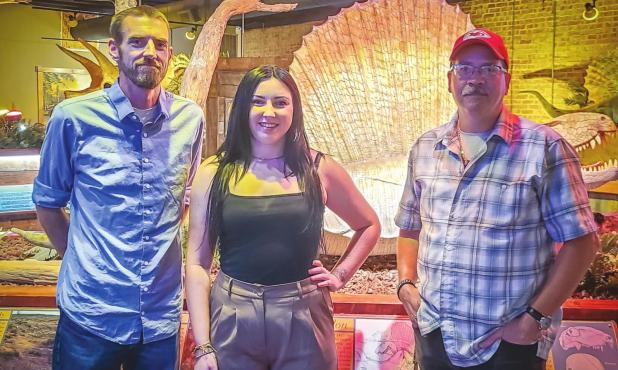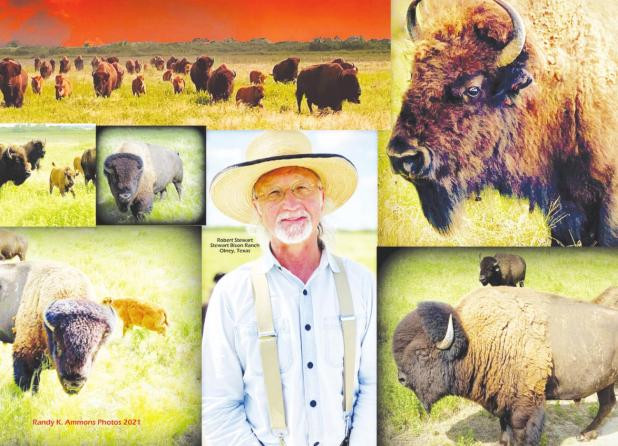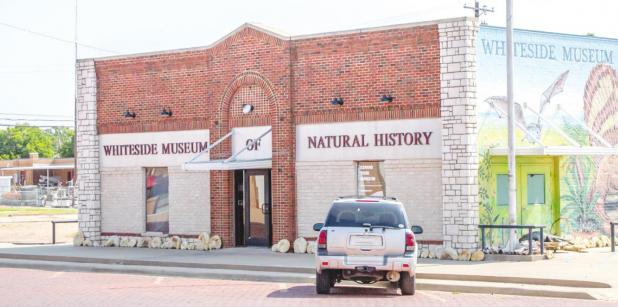


Support Local Museums Whiteside Museum of Natual History
The Whiteside Museum of Natural History (WMNH), located at 310 N. Washington Street, Seymour, is home to a world-class natural history museum. The museum is headed up by Chris Flis, the museum director and his team, Holly Simon (assistant director), Laura Nix (administrative assistant), Jacob Stripling (docent) and Robert T. Bakker (adjunct curator of paleontology).
According to the WMNH’s website, www.wmnh.org, Flis has worked in the museum and paleontology industry since 2004. He attended the University of Louisiana at Lafayette and earned a degree in English, and minored in history and French. His college studies also included geology and biology with an emphasis in paleontology, anatomy and evolutionary biology.
Flis said the Seymour area’s fossils are unique for North America and the entire planet, dating back to 1878 when the first paleontologist came through Seymour, Harvard, Princeton, Yale and the then up-and-coming Smithsonian. They would come to Seymour to collect these incredible fossils from some of the best lower Permian burbot beds in the entire world. Thanks to the formation of the WMNH in 2013, the fossils and artifacts discovered in Seymour stay in Seymour, as before the museum, many fossils would be sent all over the world to be displayed and studied.
Flis explained his interest in paleontology, stating, “My dad is now a retired Chevron geophysicist, and so he would always take me out into the field to collect rocks and fossils, dating back to around my first memories I could think of when I was five or six years old. I didn’t do normal things like children would do. I didn’t go to the movies with children. I went out to the middle of nowhere and dug up dinosaur bones.”
Flis went on to explain why he continues to work countless hours to make the museum such a huge success. He said, “The feeling that we [referring to himself and Holly] both get when we get to see the children and families coming here to see this museum, which is worth more than every penny on earth. It’s that feeling of giving something to the community that is going to last for countless generations. That’s why we do what we do.”
Flis closed the interview with a statement to children interested in the field of paleontology.
“No dreams are too big. You will accomplish anything if you are passionate about something. Pursue that passion as much as you can. The best way to get into the science field is to get your hands dirty, so to speak, and get into the museums and see how they work. And start volunteering with the museums,” Flis said.
Assistant Director Holly Simon is self-taught with five years of mentorship from other paleontologists. Simon said her duties include anything that needs to keep the museum running such as tours, fieldwork, outreach and marketing.
Simon’s advice to children interested in the field is, “Don’t give up, and take every opportunity that is given to you because those opportunities don’t come very often. And a lot of people don’t have the chance to do something like that, so put yourself out there and take as many opportunities as you can.”
Simon’s pet project or main love is the extinct genus of terrestrial tetrapod found as fossils in Permian rocks (251 million to 299 million years old) in North America and named for fossil deposits near Seymour.
Docent Jacob Stripling said he is a master docent, which includes giving tours of the museum and helping at dig sites when needed. Stripling will attend Midwestern State University in the fall. He plans to major in biology and minor in geology. The advice he offers to children who want to follow their dreams is, “Keep up with it [your dream]. It’s worth anything you want to have.”
Laura Nix, the administrative assistant to the MNHM and the first smiling face you see when entering the museum, said her duties include booking schools, groups, and anyone who would like a museum tour. Nix has numerous functions at the museum that may go unnoticed but are invaluable to the day-to-day running of the museum.
Nix said that she has always loved museums, so she put that in her résumé when a position became available. Nix was hired, and it has been two and a half years since then.
“I have always loved the museum, and I applied and was blessed with the job. I feel very fortunate,” Nix said. “Please come if you’ve not been to this museum. Children need to see it.. Teachers need to know to bring the students and come to this museum. It is full of stuff that the children will never see from here, like the Permian that predates the dinosaurs. They will never get to experience anything like it. I believe we’re the only Permian, heavily Permian-based museum in the nation, maybe the world.”
To learn more on how to plan a visit, donate funds or become a volunteer, please visit the WNHM at wmnh.org.
